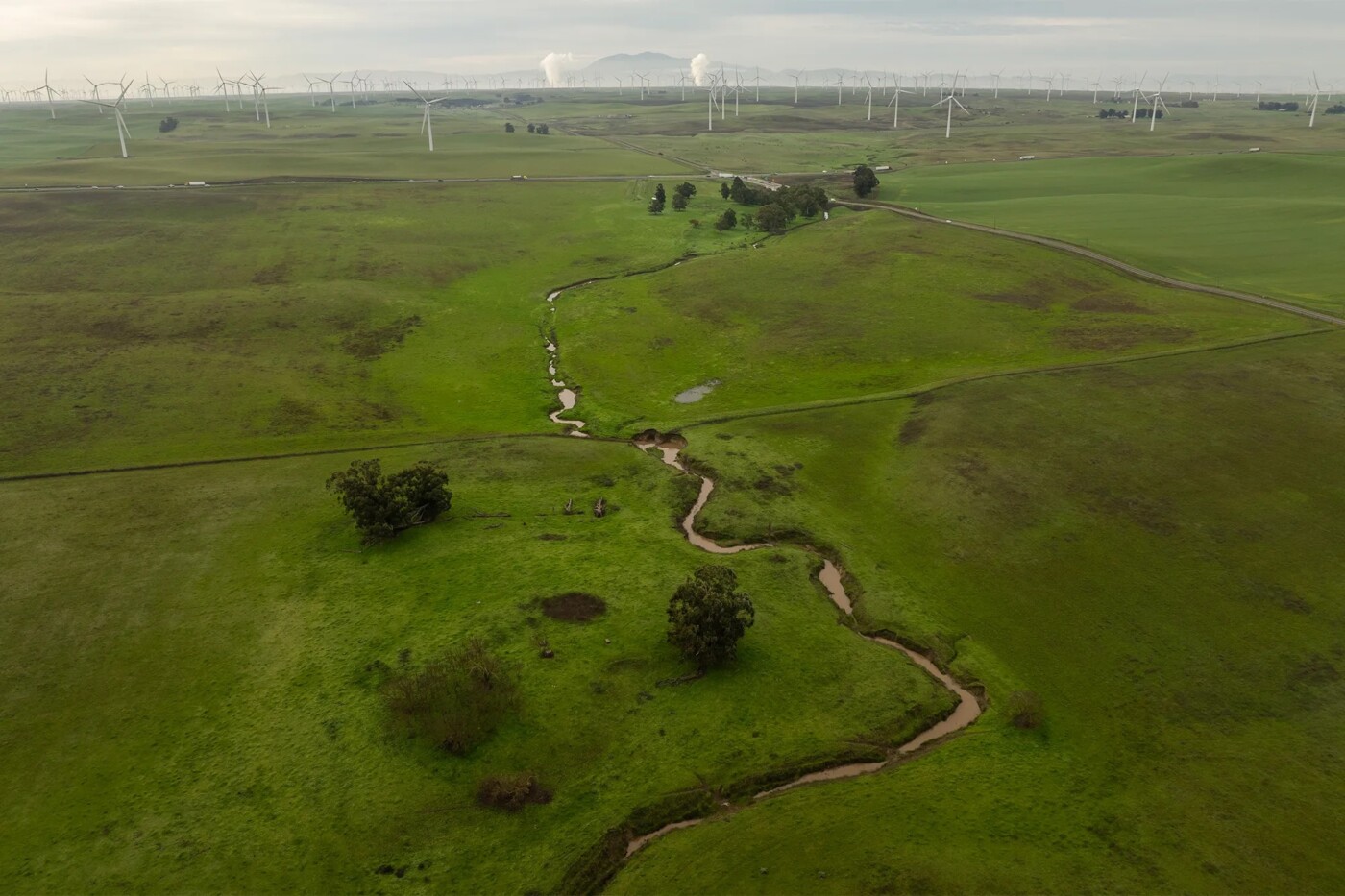The city-from-scratch that tech billionaires want to build in Solano County is getting the hard sell, with the backers promising new housing, better jobs and more — promises that will cost in the hundreds of millions, if not billions, of dollars — plus a pledge that county taxpayers outside the new community won’t have to pay for any of it.
The backers call these pledges, contained in a proposed countywide ballot initiative, “guarantees.” They say they’ll be legally bound to honor them.
But skeptical legal experts and local officials dispute the idea that the project’s developers will be obligated by law to deliver on the so-called guarantees. Because the issues would put California in uncharted territory, odds are some disputes would have to be resolved in court.
The Silicon Valley tech billionaires aim to put a nearly 100-page ballot initiative before county voters in November. The group has formed a company called California Forever — whose subsidiary Flannery Associates has spent $900 million to buy 62,000 acres of farmland (about the size of Sacramento) in the area since 2017 — that proposes to build on 17,500 acres of that land (about the size of Vacaville). They plan for the new community to attract an initial 50,000 residents, and eventually up to 400,000, which would double the population of the county.
The company is backed by a group of venture capitalists — including Michael Moritz, LinkedIn co-founder Reid Hoffman, Netscape co-founder Marc Andreessen, and Emerson Collective founder Laurene Powell Jobs — to create this new town. They promise, through California Forever and its chief executive, Jan Sramek, to spend a lot more money to build and develop the community. They say it will alleviate the state’s housing crisis, create well-paying jobs and build a walkable community on the outskirts of the Bay Area.
Although the project’s promoters insist Solano County residents outside the proposed community won’t get stuck with any new taxes or fiscal responsibilities, they acknowledge the state of California will. And those state taxpayers, of course, also include all of Solano County’s taxpayers.
“The goal is to be the master developer of this and be a real steward of the land,” Sramek said in an interview with CalMatters last week. He added that the investors in the project are in it for the next few decades at least.
Despite taking part in some contentious town-halls and other public meetings, and suing county farmers they accuse of price-fixing, Sramek and California Forever are courting voters with wide-ranging “guarantees.”
Those promises — whose dollar amounts will gradually increase with the community’s population, reaching the pledged totals at 50,000 residents — include:
- Up to $400 million in down-payment assistance to help Solano County residents buy homes in the new community and new affordable housing
- Up to $200 million invested into the county’s existing downtowns
- Up to $70 million for college, training, and educational programs for Solano County residents
- Thousands of new jobs that will pay 125% of the average annual income in the county
- An unknown sum for infrastructure for the new community, such as schools, a transportation system, and more
Skeptics abound.
“They can promise they can do a thing,” said Mary-Beth Moylan, a University of the Pacific law professor and expert on California initiatives, who said the promises are not legally binding. “But when you get into things like commitment of taxpayer money, that’s not something they can guarantee.”
Solano County Supervisor Erin Hannigan represents Vallejo, and while she’s not necessarily against the project, she agreed with Moylan. “I think (the promises promoters call guarantees) will falsely entice people to think this is a good thing” when she said there is not enough information for voters to make an informed decision. “Who’s going to enforce it? You can’t put a directive on a municipality.”
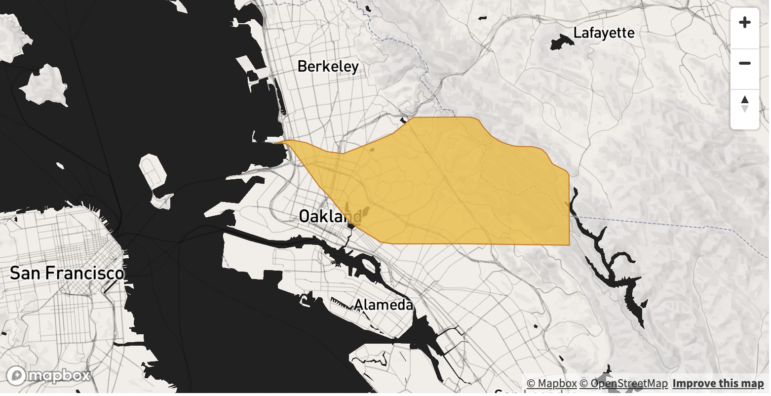
Sramek pointed to initiative language that says the community would not be able to begin development without an environmental impact report, and without reaching a development agreement with the county that would incorporate enforcement of the so-called guarantees.
California law does not allow for statutory development agreements to be passed by initiative, per a 2018 appellate court ruling. This proposed initiative refers to a development agreement that is supposed to include many of California Forever’s promises, but the company will still have to iron out details with the county.
California Forever’s backers have up to 180 days to collect 13,062 signatures after they publish the final initiative title and summary in the legals section of print newspapers in the area, said John Gardner, assistant country registrar. The company can’t do that until it gets the initiative title and summary back from the registrar after submitting a revised version of the initiative Feb. 14; the registrar is waiting on county counsel to rewrite the initiative title and summary before passing that back to California Forever. For the initiative to qualify for the November ballot, all other subsequent steps, including validation of the signatures by the registrar and a final approval by the Board of Supervisors, must be completed by Aug. 8, Gardner said.
Ahead of signature-gathering for the East Solano Homes, Jobs, and Clean Energy Initiative — which asks voters to rezone farmland and amend the county’s urban-growth-restricting General Plan — here’s a breakdown of the “guarantees” and a look at a key sticking point: the effect of a new community on Travis Air Force Base.
Taxpayer and smart-growth promises
The initiative says California Forever won’t impose any new taxes or fiscal obligations on Solano County residents outside the new community.
Any costs to the county, including current and future administrative costs, already are being reimbursed by the company, Sramek said.
Bill Emlen, Solano County Administrator, confirmed through a county spokesperson that the company has a reimbursement agreement with Solano County.
But Emlen added that because the project is being pursued through the initiative process, “we are evaluating what additional costs may be recoverable from the project proponents based on county staff time that will be required. Given the scope and scale of the proposal we believe the costs will be significant and there are already costs incurred that have not been reimbursed.”
Other potential future expenses include the cost of law enforcement. Because the new community would be unincorporated, the county sheriff’s office would be responsible — but Sramek said California Forever would pay for those costs.
“We would set up a community facilities district which could also provide services, controlled by the county,” Sramek said, adding that it would be similar to Rio Vista’s arrangement with the sheriffs. Rio Vista Mayor Ron Kott said his city pays the county for 12 full-time sheriff’s deputies.
But some of the planned infrastructure will involve or eventually involve costs to the state — and therefore Solano County residents.
California Forever’s initiative also promises that after the first 50,000 residents, its financial commitments would continue to scale up in proportion to the community’s growth. So if the community doubles, so would the dollar amounts mentioned in the guarantees.
Jobs promise
The initiative says the new community will provide 15,000 new jobs that will pay 125% of the county’s average annual income. That works out to new jobs needing to pay at least $83,850 annually, based on the most recent weekly wage numbers for Solano County from the Bureau of Labor Statistics.
But elected officials and others have questioned this so-called guarantee, partly because California Forever has not disclosed which employers are interested in coming to the proposed community, which its backers envision as hosting different types of employers, from small businesses to big ones, from coffee shops to stores. Sramek said he plans to share specific names “between now and November.”
Sramek said the new community will have “the opportunity to bring tech jobs” to the area — not just in software but also in “hard tech” such as advanced manufacturing, aerospace and defense, something akin to what he said Silicon Valley had before it ran out of space and housing in the region became too expensive for manufacturing workers to afford.
Considering the tech-industry backers of the proposed community, “if anybody can make it happen, it would be them,” said Kott, the mayor of Rio Vista, which would be the new community’s nearest neighbor.
Other mayors say there certainly will be construction jobs, especially for the first few years.
“That’s very different from long-term economic-development jobs that could sustain a community going forward,” said Steve Young, mayor of Benicia.
Robert McConnell, mayor of Vallejo, said “labor unions are the biggest supporter of this project,” referring to the fact that California Forever put together an advisory committee that included a few union leaders.
But Jon Riley, executive director of the Napa/Solano Central Labor Council, which consists of 48 affiliated unions in the region, said labor has not taken a stance — though he was on the committee, along with other public officials and business leaders. Until the unions take a vote on whether to support the initiative, he said he would not be doing interviews.
The initiative states that if the jobs “guarantee” is not met, the county won’t have to approve any more home development beyond that for the first 50,000 residents.
Hannigan, from the Board of Supervisors, again: “The ‘guarantees’ are tied to progress. It’s hard to hang your hat on it.”
Housing promises
Perhaps the key selling point of the proposed community are the 40,000 to 160,000 new homes that could be built at the edge of the San Francisco Bay Area, a region where places to live are in desperately short supply.
Sramek and other California Forever representatives stress that this isn’t your typical sprawling commuter suburb, and that the town will consist of a dense mix of apartments, condos, town- and rowhouses and backyard cottages, all across a matrix of bike paths and pedestrian-friendly boulevards. This meticulous vision of city life is meant to appeal to design geeks, urbanists and people who spent a lot of time playing SimCity growing up. But the heart of the new town would still be a 48-minute bicycle ride from downtown Rio Vista, the next closest community, according to Google Maps. There aren’t immediate plans to incorporate the city into current public bus and rail networks, as that would require buy-in from regional and state public transportation agencies. In the meantime, the company plans to start with a private shuttle system, California Forever’s planning chief, Gabriel Metcalf, said in a recent interview with the pro-development publication SF YIMBY.
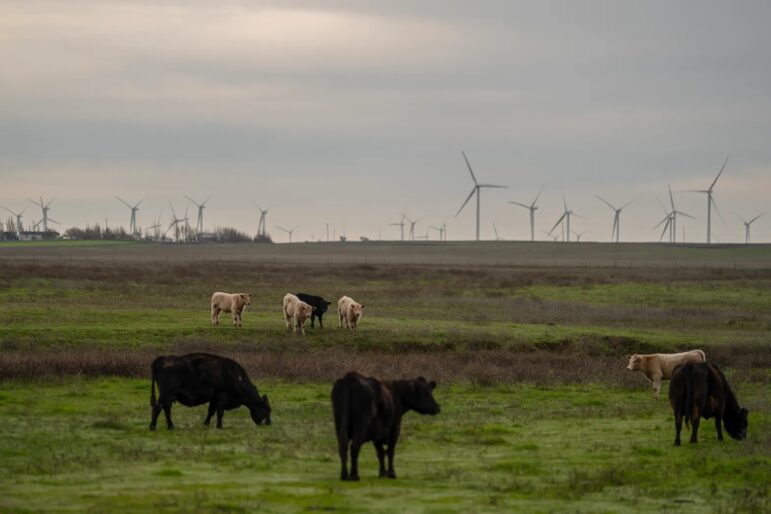
An exceedingly optimistic projection of how much it would cost to build even just 40,000 units would be less than $10 billion. Both Sramek and Metcalf have said that California Forever isn’t likely to front all of that money, but would instead play the role of “master developer,” in which they build the infrastructure and secure the legal right to build before selling off individual parcels to builders.
Whatever arrangement the company arrives at, building a fully fledged town out of nothing won’t be cheap.
In addition to the pledge to build new homes by the thousands, the billionaire-backed venture is also offering, as one of its “guarantees,” to spend $400 million on affordable housing developments and down-payment assistance for future residents.
What kinds of affordable housing projects will get built and for which types of residents? How will any down-payment assistance grants be divided up and under what terms? Who will be tasked with overseeing this nearly half-a-billion dollar spending bonanza?
That is all TBD.
Sramek said such details would be hammered out through a “community engagement process” and negotiations with the county government, assuming the ballot measure passes. Those negotiations would culminate in a broader development agreement that would spell out the when, where and how of the entire town-building project. Developers regularly enter into such legally binding contracts with local governments over the nitty-gritty of how a project gets built.
That agreement would also dictate some of the terms under which new homes actually get built in the hypothetical new community. But Sramek and the other backers of California Forever have a clear preference for how construction should take place: quickly.
The ballot measure would require the county to approve preliminary applications for development, including those for new housing, within 60 days. That’s blow-your-hair-back-fast, by California development standards.
Then, assuming a project is consistent with zoning and a set of broad design rules, the initiative dictates that the county would have no choice but to approve them — no discretion and no public hearings. The decision would also be exempt from environmental review and any related lawsuits. In housing policy jargon, this approach to development is known as “by-right” or “ministerial” approval, a glidepath standard that “yes in my backyard” advocates have been inserting into state law for specific, favored project types. This would make the entire community a YIMBY-happy oasis of ministerial approval, a complete inversion of the status quo in neighboring San Francisco.
The county and California Forever will be able to tinker with the details of the approval process in a future development agreement. But legally they can only fill in gaps left by the ballot measure. They can’t override it.
“Our goal is that a complying project can be approved in 10 days,” Metcalf said in the SF YIMBY interview. “We’re not looking to have people involved in telling other people what they can build.”
That vision has already stirred up additional opposition from some local elected officials.
In an interview with the San Francisco Chronicle, Democratic U.S. Rep. John Garamendi, whose district includes the neighboring Travis Air Force Base, expressed concern over the “the inability of the county government to control what goes on” in the new development.
But there may be limits to how much the ballot measure can do to speed up the growth process. Before developers can start dropping homes onto cow pastures, they first need to legally divide the land up into individual parcels — a process known as subdivision.
California courts tend to “give Solano County discretion over subdivision approvals,” UC Davis law professor Chris Elmendorf said in an email. “I don’t think the ballot measure can make subdivision approvals ministerial.”
Translation: He doesn’t think California Forever can streamline every step of the development process with a single ballot measure.
This isn’t the first time private money has sought to build an out-of-nowhere city, not even in California. In the late 1950s the Irvine Company commissioned “starchitecht” William Pereira to design from scratch a city to serve the newest University of California campus in Orange County. Thus: Irvine.
But the history of proposed cities is also littered with extravagant failures, especially in unincorporated Solano County.
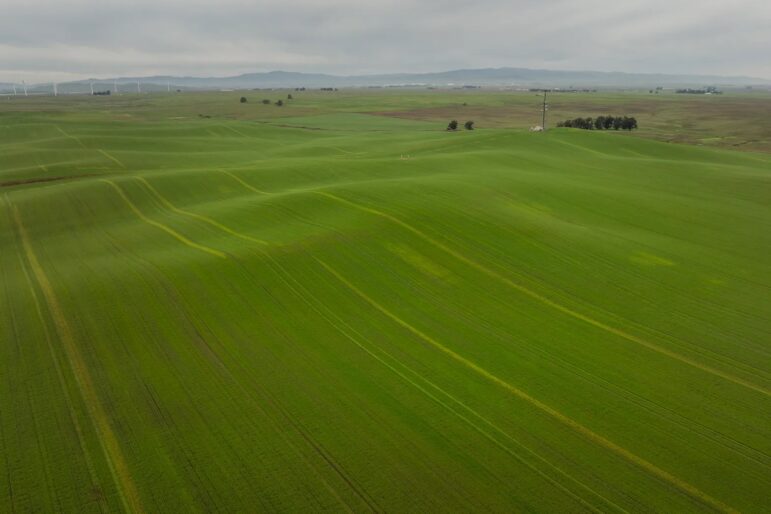
According to the San Francisco Chronicle, in 1913, a wealthy cadre of San Franciscans, including the then-owner of that paper, bought up nearly 100,000 acres of north Bay Area farmland in the hopes of building Solano City — “the most beautiful city in America.” The project went bankrupt before a single house was built.
In more recent history, a San Francisco developer spent the early 1980s trying to build Manzanita, a 2,000-home subdevelopment not so far from the current plot selected by California Forever. Even the pitch made by developer Hiram Woo sounds familiar in 2024: “A self-contained community with families of different income levels living together with a lot of amenities they can enjoy,” he told the San Francisco Examiner at the time.
That project, along with another one nearby, prompted a public backlash from locals worried about sprawl and the loss of agricultural open space. In 1984, voters enacted a county-wide “orderly growth” policy, which requires any new development outside Solano’s seven current cities to receive electoral approval before it can break ground. A year later, the local electorate voted down the Manzanita project by a two-to-one margin.
Four decades later the policy is still in place, which is why California Forever’s vision is in Solano County voters’ hands.
Transportation promise
California Forever also promises in the ballot initiative to pay “more than its proportionate share of costs” to upgrade Highways 12 and 113, the two main ways to get to the proposed community.
Sramek said “proportionate share” will be tied to how much the new community’s residents use those highways, and those terms will be specified in the development agreement.
The initiative also says “future improvements shall be developed with Solano Transportation Authority, Caltrans, and other stakeholders.” That means other costs would be shouldered by local and state taxpayers, because highway projects involve multiple agencies.
The Solano Transportation Authority is neutral on the project, said Daryl Halls, its executive director. But he has questions.
“When I hear ‘guarantee,’ I don’t know how they’re going to guarantee anything,” he said, particularly when it comes to widening or making other improvements to highways, where regional and state partnerships are critical.
“There’s a lot of taking your turn,” Halls said. “We’re competing against 57 other counties for projects.” He also said that highway projects take a lot of time, and involve air-quality concerns, environmental studies and more.
Another agency likely to be involved would be the Metropolitan Transportation Commission, which handles transportation planning and financing for the Bay Area.
Rebecca Long, its director of legislation and public affairs, said she read the proposal, which also included a possible rail connection between the new community and the Fairfield-Vacaville Amtrak station.
Long said she saw “no guarantee of a funding stream of this magnitude that could fund these projects. They would have to secure massive discretionary (government) grants, which are not particularly favorable toward highway-widening projects.” In addition, she said if the planned highway-widening were to be funded and approved, “you’re looking at a decade at a minimum to go from designing it to constructing it.”
As for other transportation, the rapid-shuttle program Metcalf spoke of would be made up of buses within the county and financed by California Forever. In the long run, he said such a program could run between Sacramento and the Bay Area.
“We can be a catalyst and primary funder of transportation lines,” Metcalf said on stage at Solano Economic Development Corporation’s annual meeting in early February.
Schools and scholarships promises
Usually, California schools are built with state and local funds, with cities asking residents to approve local bonds that can then be repaid over decades. The question, then, is which will come first, the schools or the taxpayer base of the new community?
California Forever’s initiative says its new community’s schools will be paid for by state school construction programs, school facility improvement grants and other sources.
But Sramek said his plan is for the community to have everything it needs “from Day 1,” including schools. That means “it’s very possible that we will subsidize a school,” he said, then expect to be paid back as the community grows.
In the past few decades, California’s K-12 schools have been financed about 50-50 by the state and local governments, said Jeff Vincent, director of the UC Berkeley Center for Cities & Schools, adding that cities can end up paying more depending on how specialized or fancy a campus might be. Cities also collect developer fees that go toward school construction.
“I suppose it’s conceptually possible they could front the money, then get repaid,” Vincent said, adding that to collect state funding, the new community would have to meet eligibility requirements related to expected number of students.
But even if California Forever fronts the money for construction of a school, it will still need to go through state approvals that could take a long time. From conception to design to construction, two to three years would be an overly optimistic timeline, Vincent said.
He offered rough estimates of how much schools cost to build: $25 million for elementary schools, $50 million for middle schools and $100 million and often more for high schools.
The California Education Department referred CalMatters to the Solano County Office of Education, whose superintendent refused requests to talk with CalMatters for this story. “There are several unknowns and variables at this point, so it feels too soon to speak to the topic,” said Jennifer Leonard, a spokesperson for the county’s education office.
The California Office of Public School Construction also did not return calls for comment.
A separate “guarantee” for scholarships in the initiative says California Forever’s investors will spend $70 million toward college, training and education, whose details are supposed to be included in the development agreement. It’s what Sramek called a “community benefit” that California Forever would grant to existing Solano County residents.
Water and ‘Green Solano’ promises
Sramek said California Forever has secured enough water for the 50,000 initial residents of the proposed community, and maybe even the first 100,000.
The water rights came from the land the company has bought, he said, and are sourced from groundwater and the Sacramento River. The company could buy more water to supplement that, but wouldn’t need it for the first buildout, he said.
The water-supply verification process would not be handled at the state level, said Ryan Endean, a spokesperson for the California Department of Water Resources.
The Solano County Water Agency has not received a proposal to provide water to California Forever, said Alexander Rabidoux, assistant general manager for the agency. If and when it does, the agency’s board would discuss such a proposal publicly, Rabidoux said.
Other officials, many of whom have been dealing with water and drought issues for years, are concerned about the effects on their water supply.
Kott, the mayor of Rio Vista, said he has talked with California Forever about a possible memorandum of understanding about water. “The development they’re proposing is north and west of our city and could affect our water supply,” Kott said.
Catherine Moy, mayor of Fairfield, said “Flannery’s land gets its groundwater from the same sub-basin as Suisun Valley,” which is trying to grow its wine industry. “We need to raise that question quite a bit… the impacts are real.”
The Green Solano “guarantee” commits $30 million toward improving parks and trails, and “supporting Solano’s agriculture economy, including family farms and agricultural workers.”
Sramek said that in the company’s conversations with the community, there is disagreement about where this money might go. It could fund trails, go toward habitat conversation or help young farmers who want to get into the business, he said. California Forever will commit the money and the development agreement could spell out how the money would be allocated, he said.
Greenbelt Alliance, a Bay Area nonprofit that’s dedicated to protecting open space, is among the opponents of the proposed new community. It also belongs to Solano Together, a coalition of opponents to the project, and is collecting funds for a planned competing ballot initiative if California Forever’s initiative qualifies for the ballot.
“It is pretty bold to include a promise to ‘protect and improve open space and agriculture’ in an initiative that simultaneously asks voters to approve development of over 17,000 acres of open space and agriculture,” said Sadie Wilson, director of Planning and Research at Greenbelt Alliance.
Solano County downtowns promise
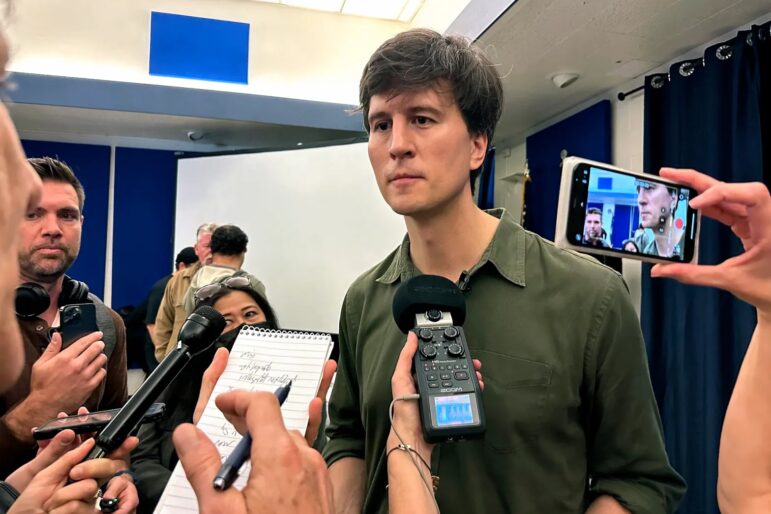
California Forever’s initiative promises a $200 million investment in the seven existing downtowns of Vallejo, Fairfield, Benicia, Vacaville, Suisun City, Rio Vista and Dixon, proportionate to their populations. Sramek said this would be a commercial investment — meaning the company expects returns — that would involve the company owning and operating buildings in the downtowns around the county.
Some mayors of existing downtowns say the promised investment sounds good, but they don’t know how it would work yet.
“Would it be nice to have another $25 million to $30 million invested in downtown?” asked Vacaville Mayor John Carli. “Sure… but I haven’t heard how Vacaville would get that money.”
Kott, mayor of Rio Vista, is worried about the new community diverting shoppers, and therefore sales taxes, from his town.
“We’re probably going to feel the most effects,” Kott said. “Unfortunately everyone else in the county will be voting for this. I see upsides and downsides.”
Princess Washington, mayor pro tem of Suisun City, said on stage during the Solano Economic Development Corporation meeting: “Do we want to vote for an initiative that will undermine what we’ve been working toward, which is to drive growth and investment into our seven cities?”
But Kott added that California Forever appears to be willing to listen to its neighbors’ concerns, such as when the company added in its plans a park that Kott says will act as a buffer between the new development and his city, which will allow Rio Vista to keep its small-town feel: “If you’re willing to work with them, they’re willing to work with us.”
Concerns about Travis Air Force Base
If approved, the new community would be built between Rio Vista and Travis Air Force Base. That’s important for many reasons.
“Landing and takeoff space is impacted by the project,” state Sen. Bill Dodd, the Democrat whose district includes Solano County, told CalMatters. “There are safety and security problems. Travis is the largest employer and economic driver in Solano County.”
California Forever’s promises, such as down-payment assistance and scholarships, also extend to the base’s residents, according to its CEO’s public statements and the company’s website.
And in response to continued concerns about Travis, California Forever last week submitted a reworded initiative that included designating 4,200 acres as “Travis Compatible Infrastructure,” which would limit the new community’s uses in that area to infrastructure, agriculture and habitat preservation.
Sandy Person, executive director of the Travis Community Consortium — a group of civic and business leaders that advocates for the interests of the base — said she is “not able to comment at this time.” The consortium has said that Travis has a $2.7 billion annual economic impact on the region.
Laurene Powell Jobs oversees the Emerson Collective, which has donated to CalMatters. CalMatters retains full authority over editorial content, maintaining a firewall between news coverage decisions and revenue sources.
